The TRANSIT project: innovation towards train pass-by noise source characterization and separation tools
By Inés López, project coordinator, Technische Universiteit Eindhoven (TUE); Mats Åbom, KTH Royal Institute of Technology (KTH); David Thompson, ISVR University of South Hampton; Ennes Sarradj, Technical University of Berlin (TUB); Marta García, Union des Industries Ferroviaires Européennes (UNIFE); Ester Cierco Molins, Ingeniería para el Control del Ruido (ICR); Michael Dittrich, Netherlands Organization for Applied Scientific Research (TNO); Martin Rissmann, Vibratec; and Juan Moreno García-Loygorri, Metro Madrid
Railway transport produces less CO2 and consumes less energy than road and air transport modes; it also requires less space than road transport. However, noise and vibration (N&V) levels in the vicinity of railways are a major environmental challenge for the railway sector. Populations close to railways no longer accept the increasing N&V annoyance and a competitive railway transport system demands better passenger comfort.
Noise reduction is addressed to some extent by the requirement of the Technical Specifications for Interoperability (TSI) for all new vehicles to meet noise limits in both pass-by and stationary conditions. Due to the high cost involved in such tests, it is desirable to develop virtual testing and some progress has been made in a previous project, Acoutrain, towards this.
In Acoutrain, source characterization methods, and exterior noise simulation tools aimed at virtual certification, were developed, and validated for a few cases; however, these were limited in terms of the speed and type of vehicles considered. These tools and models should urgently be further developed to include other practically relevant scenarios. This will require including source integration effects such as the effect of skirts or fairings.
In addition, advanced measurement methods are required that can identify the noise contributions of different sources on an operational train. The relative importance of the various vehicle sources, as well as the track, needs to be better understood.
The overall goal of TRANSIT is to provide the railway community with a proven set of innovative tools and methodologies to reduce the environmental impact and improve the interior acoustic comfort of railway vehicles. A summary of the TRANSIT Applications and Impacts is presented in Figure 1, while the main objectives of the TRANSIT project are:
• Reduction of rail vehicle noise certification lead time and costs, and lower operator’s track occupation requirement for testing by providing accurate virtual certification tools,
• Reduction of the need for a TSI-compliant track by developing and demonstrating accurate separation and transposition techniques,
• Derivation of a more precise and better-founded definition of acoustic requirements for equipment suppliers, reducing time and cost,
• Improved source quantification for noise mapping and a more accurate assessment of noise abatement measures,
• Enabling lighter vehicles, thus lower energy consumption, while maintaining high levels of interior acoustic comfort.
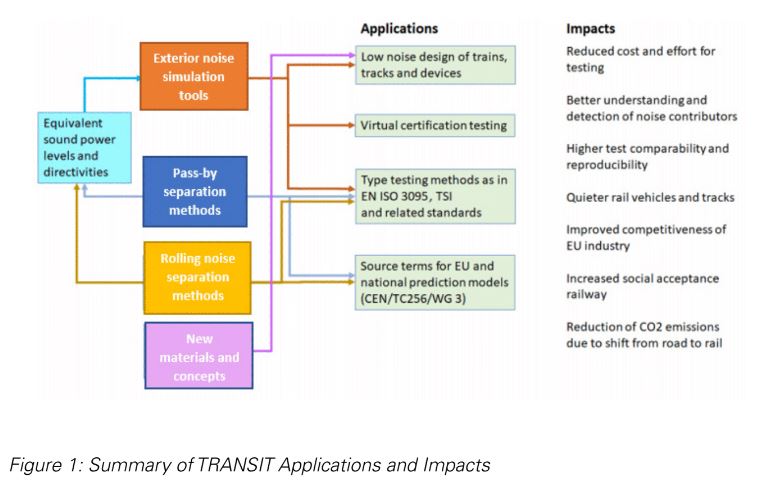
The TRANSIT consortium integrates members with considerable experience in the railway sector, who have a successful history of collaboration in this field, with expertise from other sectors, such as the aerospace and automotive industries. They bring leading-edge knowledge on topics ranging from best practices in the use of computer-aided engineering software tools for virtual prototyping and certification of products to advanced microphone array technologies for source separation. These advanced methodologies will be transferred to the railway industry to optimize rolling stock and infrastructure design using lightweight metallic and composite structures, passive, and smart active materials, thus gathering the key expertise required to realize the innovation sought in Shift2Rail (S2R). TRANSIT is a project that uses other previous and ongoing projects outcomes in order to successfully analyze all the data. The outcomes used in TRANSIT are based on the past EU and ongoing Shift2Rail Joint Undertaking projects:
• Roll2Rail: aimed at developing key technologies and removing already identified blocking points for radical innovation in the field of railway vehicles, as part of a longer-term strategy to revolutionize the rolling stock for the future. The results contributed to the increase of operational reliability and to the reduction of life cycle costs. Methods to separate infrastructure and rolling stock noise contributions were developed and tested.
• Acoutrain: introduced virtual certification with a reliable simulation approach; Established measurement procedures for new running conditions, specifically braking and curving; Developed procedures to obtain inputs for the European Noise Directive.
• FINE-2: This is the ongoing S2R Members project aiming to reduce the annoyance and exposure to noise and vibration by developing future methods for predicting the overall noise and vibration performance of trains. Moreover, FINE-2 aims at ensuring that the research & innovation activities dealing partially or entirely with energy, noise, and vibration.
Most of the activities in TRANSIT are focused on the experimental characterization, modeling, and separation of railway noise sources (at standstill and during pass-by) as well as the further development of the Acoutrain external noise prediction tool to account for installation effects in the transmission paths. New test methods are also developed to quantify noise transmission paths from sources on rail vehicles to the standard microphone positions accounting for installation effects.
In addition, the project is also investigating innovative materials and methods for improved acoustic comfort. New and innovative approaches will be used to improve the design of the interior acoustics of future rolling stock. Several possible approaches are being considered, including optimal sound absorption at the source, damping along ducts for air conditioning systems, and innovative use of meta-materials for the car-body parts.
Figure 2 represents the global approach of the TRANSIT project, in particular, the translation of the high-level objectives into technical objectives. It also shows the methodology implemented within the project.
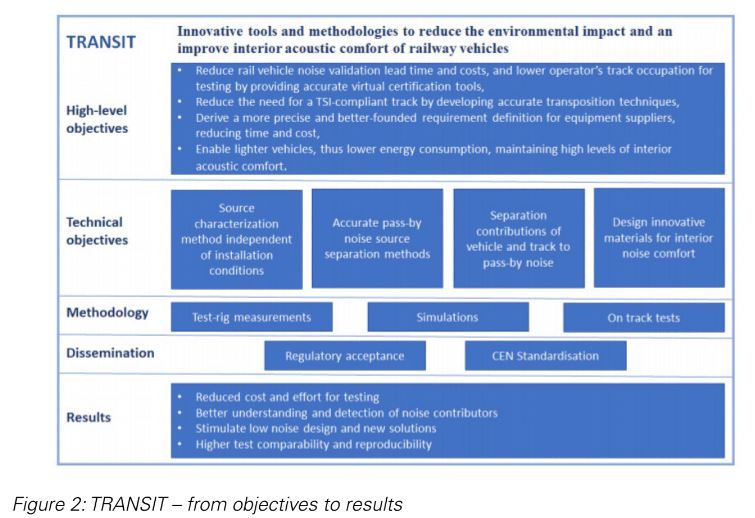
The main expected impacts of TRANSIT arise from the methods and tools that will give a better understanding and quantification of the contribution of the different sources to the total pass-by noise. That will, in turn, lead to innovations in low noise design of vehicles and tracks, virtual certification testing, and the derivation of source terms for EU and national prediction models, among others.
TRANSIT will provide an accurate description of sound power levels and directivities of individual noise sources, which is the key to future breakthrough developments in railway design and (virtual) certification testing. The expected impacts include a reduction in cost and effort required for certification testing, greater comparability and reproducibility of test results and ultimately improved competitiveness for the EU rail industry, and increased social acceptance of railways leading to modal shift.
There are four workstreams, each of which has already obtained specific technical achievements, as described in the following:
1. Source and transmission characterization for exterior noise
A method of source characterization based on equivalent monopoles has been developed from an earlier method developed in Acoutrain, by introducing a new simplified procedure assuming uncorrelated monopoles. The simplified procedure is based on sound power data determined via an ISO procedure e.g. ISO 3744 or 9614. The simplified procedure uses a calibrated monopole source to also characterize the transmission and has been validated for generic sources in the report (D1.1): “Validated procedure for source characterization based on equivalent monopoles and tests involving generic sources”.
The method developed is based on the assumption that the source is a time-invariant acoustical system. The system can then be described using a black-box model or as a multi-port as illustrated in Figure 3. For the acoustic case, the state variables are often taken as force & velocity (F,u) or pressure & volume flow (p,Q). In this case, when air-borne sound is of interest the best choice is to use p and Q. If we enclose a machine by a control surface that is divided into “small” areas and associate each area with a port defining pn and Qn, we get a multi-port source model for the machine.
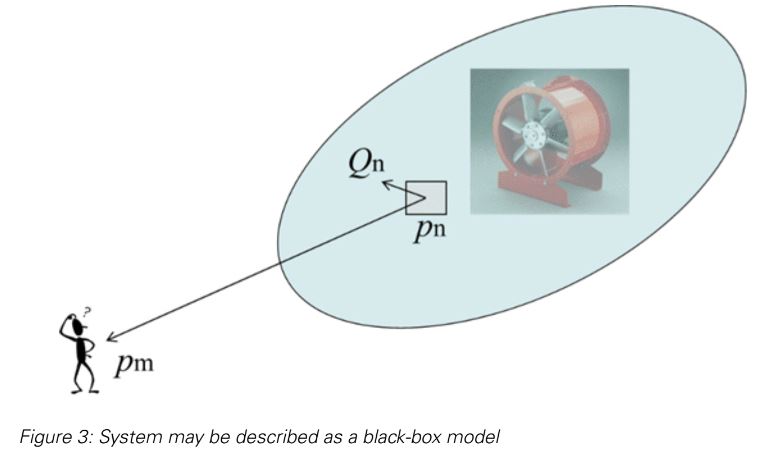
The model can then be formulated in terms of a matrix equation in the frequency domain, which can be written in the form of a source cross-spectrum matrix which when multiplied with a frequency response (“Green’s”) matrix gives the acoustic spectra pm at given receiving positions. For more details please refer to the full task report D1.1.
To summarize, the work in TRANSIT for the source & transmission is based on two approaches:
• The full model (correlated monopoles) uses an acoustic array and assumes Green’s matrix is known (Figure 4). To improve the prediction iterative Bayesian focusing (IBF) is used.
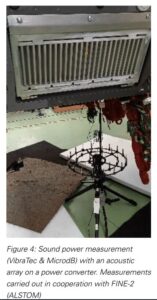
• In the simplified model sound power data Wi in frequency bands is first determined based on an ISO standard. It is then assumed that each side of a machine represents an uncorrelated monopole with a corresponding monopole source strength auto-spectrum.
To validate the simplified model generic source tests at KTH have been carried out. Figure 5 shows some examples of the tests conducted.
In conclusion, source characterization based on equivalent monopoles has been presented, with a new simplified procedure assuming uncorrelated monopoles.
The simplified procedure is based on sound power data determined via an ISO procedure e.g., ISO 3744 or 9614. The simplified procedure uses a calibrated monopole source to also characterize the transmission. The simplified procedure has been validated for generic sources (Table 1), see the task report D1.1 for more details.
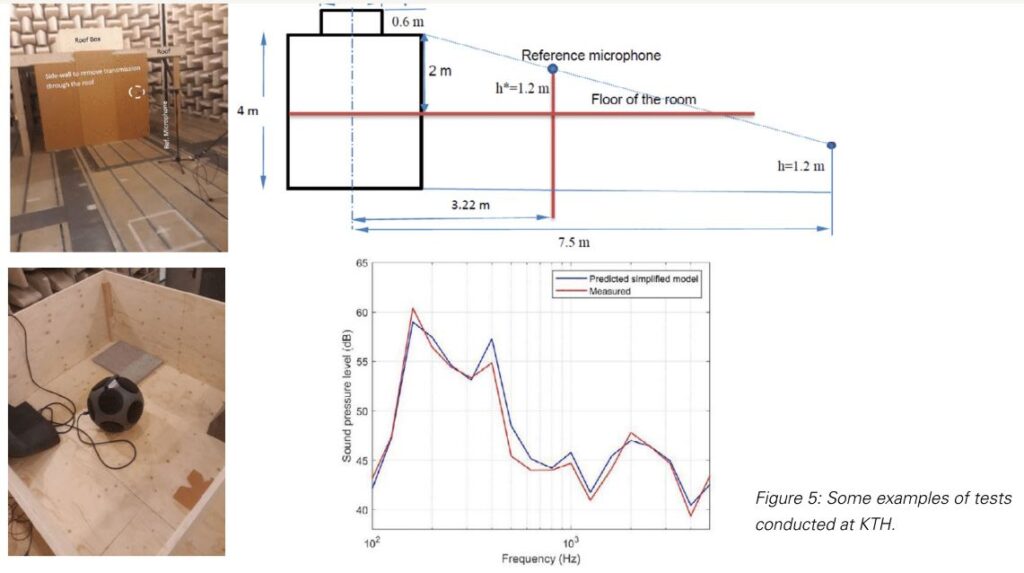
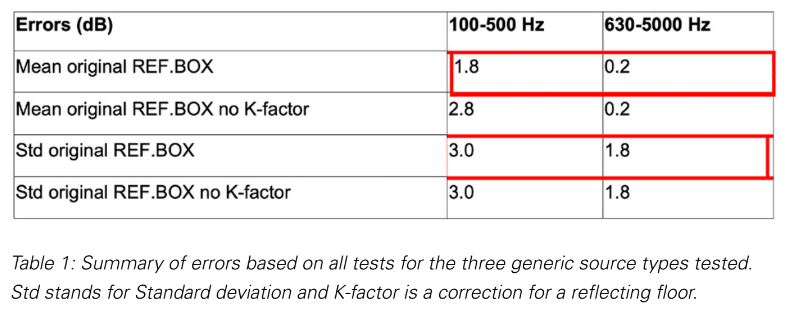
2. Pass-by noise source separation
The aim here is to obtain the sound power level and directivity of noise sources on a moving train during pass-by at a constant speed. The main sources considered (Figure 6) are aerodynamic noise, traction noise, equipment noise, and rolling noise. Two different methods are investigated: i) with a microphone array and ii) with a single microphone and rail-mounted accelerometer (PBA-based).
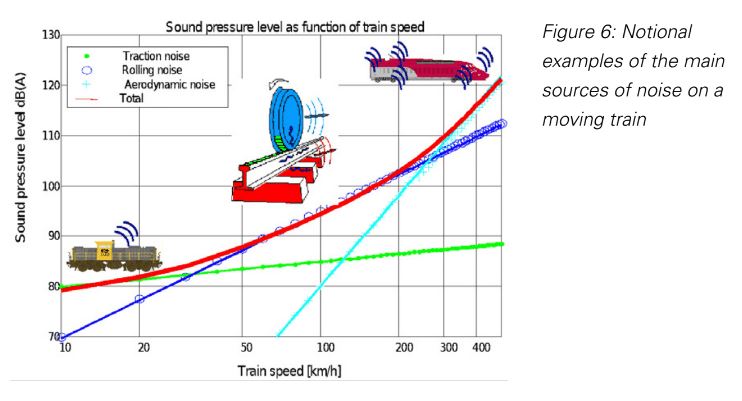
The PBA-based method (Figure 7) uses measured operational rail acceleration to assess indirect combined wheel/rail roughness levels. A vibroacoustic transfer function is derived from combined roughness and track-side sound pressure levels.
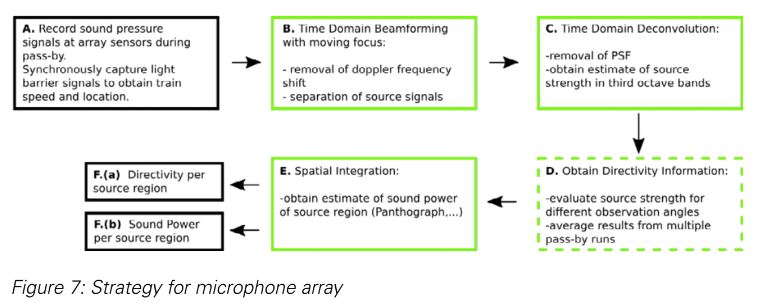
The rolling noise transfer function can be assessed from the operational pass-by of vehicles with dominating rolling noise, (parts of) the vehicle without traction noise or low-traction noise, a high-speed train at medium speed; vehicles with high wheel roughness; stationary measurements on track and vehicle by hammer impact or reciprocal measurements using an artificial sound source.
Non-rolling noise sources will show up as deviations from the rolling noise transfer function, and the pass-by level of “rolling noise-only” is estimated from the sum of indirect roughness level and rolling noise transfer function.
The source separation methods based on a microphone array (Figure 8) consist of measuring train pass-by noise with an arrangement of microphones (at least 64 channels) and the application of acoustic imaging techniques for source separation (beamforming, advanced spatial filtering deconvolution, inverse methods).
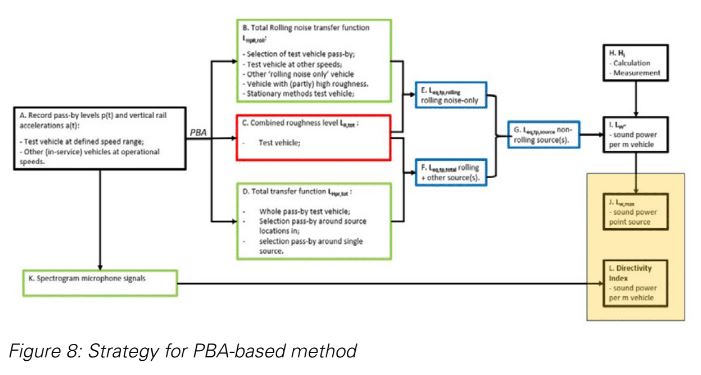
To this end, beamforming state-of-the-art methods consisting of delay-and-sum beamforming in the time domain (with moving focus) and de-popularization of source signals, only provide a relative comparison between noise sources (no information about directivity and absolute source strength).
In addition, a CLEANT deconvolution method is applied as well as the Iterative deconvolution method – de-dopplerization of source signals using a time-domain approach that can be used to estimate source strength via sector integration (See Figure 9).
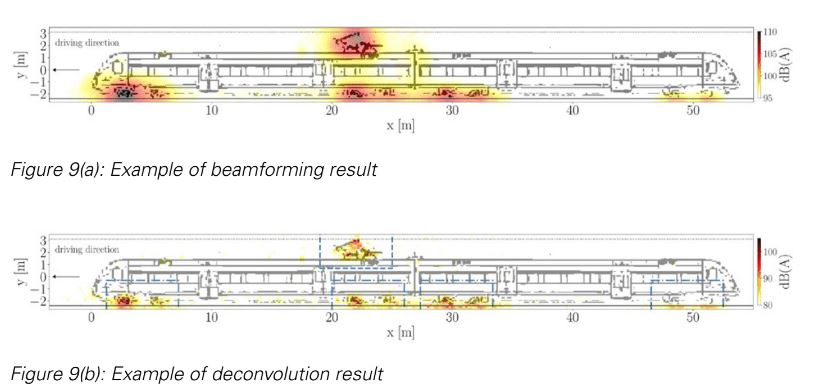
3. Separation of track noise and vehicle noise:
TRANSIT is working on the development of enhanced methods for separating vehicles and track contributions to rolling noise. The Technical Specifications for Interoperability Noise specify noise limits for new vehicles. These have to be measured on a track with a low contribution to the noise, specified in terms of track decay rate and rail roughness level. But the track noise (and roughness) is still an important contributor to the overall level, meaning it is difficult to compare results from different sites; it is important to be able to separate the contributions of vehicle and track, to identify and promote low noise design.
In TRANSIT, promising techniques from the Roll2Rail project are being further developed (simplified and/or enhanced). The aim is to provide estimates of the contribution of the vertical and lateral rail vibration, the sleeper vibration, and the wheel vibration. The methods should also be able to ‘transpose’ pass-by data measured on one track to another track; wheel and rail roughness separation should also be achieved. The methods are being validated using field measurements in collaboration with the FINE-2 project.
The proposed innovative separation methods to be considered and further developed are:
• TWINS model (Track-Wheel Interaction Noise Software): the TWINS model for rolling noise was developed and validated in the 1990s. It includes a series of engineering models for vibration and noise radiation of wheel, rail, and sleepers and excitation by combined surface roughness.
For source, separation TWINS is used with measured rail vibration. The approach effectively only uses the noise radiation part of the model (which has less uncertainty than the vibration part).
Improvements in TRANSIT are based on recent developments in modeling rail radiation and sleeper radiation. The need to include the effect of reflections from the underside of the vehicle is being investigated, by using 1:5 scale models and boundary element calculations to verify these effects (Figure 10). The final aim is to develop a set of ‘standard’ vibro-acoustic transfer functions for the track so that track noise can be estimated simply from measured rail vibration.
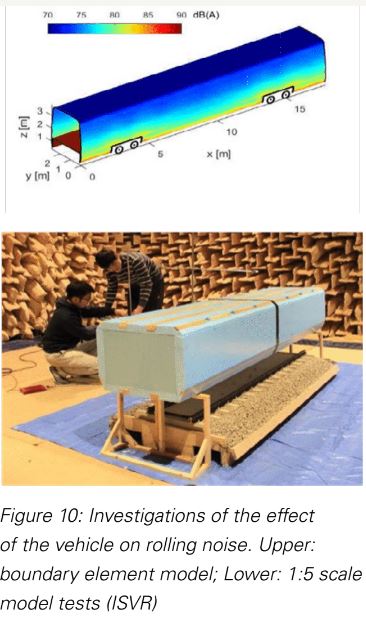
• Pass-By Analysis with input based on microphone signals, and vertical rail acceleration signals of multiple pass-bys at different speeds. The outputs are the track decay rate from rail vibration, combined effective roughness levels, and combined vibro-acoustic transfer function. Consequently, the results are the separation of roughness excitation and response (combined vehicle and track), and wheel/track separation is still needed.
Separation of vehicle and track components is considered in the project, based on PBA combined transfer functions that can be combined with separately measured transfer functions p/F for vehicle and track (static measurements). For these, two different methods are compared: the direct method (excite with a hammer) and the reciprocal method (excite with a loudspeaker). This results in separated contributions of rail (vertical/lateral), wheel (axial/radial), and sleeper. Separation of wheel and rail roughness will be performed through PBA, obtaining a combined effective roughness with the proposed method to identify rail roughness. This involves monitoring of mixed traffic, identifying minimum combined roughness levels in each wavelength band, and providing an upper bound for rail roughness.
• Advanced Transfer Path Analysis (ATPA) is an experimental method for obtaining noise contributions from different parts of a system (subsystems), by decomposing the sound pressure at a target location as the sum of the noise contributions considered. To apply ATPA to rolling noise separation the relevant track section is divided into subsections (Figure 11). Both static measurements (with hammer excitation) and dynamic (pass-by) measurements are carried out and combined. Each subsection (red dashed box) includes a vertical accelerometer on each rail, a horizontal accelerometer on each rail, and a vertical accelerometer on one sleeper. Four wheels of one bogie are instrumented in radial and axial directions.

TRANSIT project will work in the simplification of ATPA in terms of equipment, time, and resources. Simplifications may come from different approaches: measuring a reduced set of static functions and deducing the rest from the calculation, assessing the use of reciprocally measured static functions, or measuring the static functions without the train present on track and applying some corrections coming from FEM-BEM models.
4. Innovative designs in materials and methods for interior noise
Finally, the TRANSIT project is exploring innovative approaches and material designs for improved interior sound comfort. This started with a feasibility study for a number of potential solutions to proposed case studies and is continuing with an in-depth analysis of the two most promising solutions. The feasibility is studied of innovative designs and methods, focusing on meta-structure designs and other tailored material design, acoustic performance characterization of baseline and new designs through simulation or small-scale measurements, and validation of the acoustic performance of new designs in near-realistic conditions. The potential for interior noise reduction is assessed based on the existing literature and additional simulations based on Finite Element (FE) and analytical models. The two most promising solutions have been chosen for further development.
Designs related to increasing sound absorption are being developed in two steps: first, the designs will be optimized for small samples that can be validated in an impedance tube and the final design will be implemented in a real scale prototype to be tested in the lab. In the case of designs related to increasing sound transmission loss (STL) and reducing vibration transmission, designs will be simulated based on FE and analytical models, and prototype plates will be built and tested at the Marcus Wallenberg Laboratory at KTH. Different components and materials are being analyzed in the TRANSIT project.
For example, noise reduction in an HVAC duct system has been analyzed. Simplified ultra-thin low frequency (UTLF) resonators arrays, were employed in a feasibility study for application in HVAC ducts with the result that a high number of single UTLF would be needed. The simplification proposal of the TRANSIT project is that of a membrane with an array of small masses and a perforated plate. In addition, the optimization of design through Cremer impedance has been considered in order to create optimal damping of certain acoustic modes in a duct.
Moreover, pantograph area design solutions based on the so-called acoustic black holes (ABH) have been investigated, with reflection-free terminations. The velocity of the reflected flexural wave is reduced to zero, provided that the thickness vanishes at the tip of the wedge. For m≥2 (Figure 12), the flexural wave never reflects back. Some considerations are outlined:
Residual thickness (Figure 12) reduces the absorption, but the addition of a thin strip of damping material significantly reduces the reflection coefficient.
Frame design (Figure 13): Structure-borne (SB noise) can be controlled through the design of a dedicated frame for pantograph supports based on ABH to reduce vibration transmission from the pantograph to the roof. It is composed of a double–layer beam with one-dimensional ABH.
Roof plate design (Figure 14): SB and AB noise, based on ABH to potentially reduce both airborne and structure-borne noise caused by the pantograph. A characteristic length of about 18-28 cm was chosen considering the frequency of interest and typical car body materials.

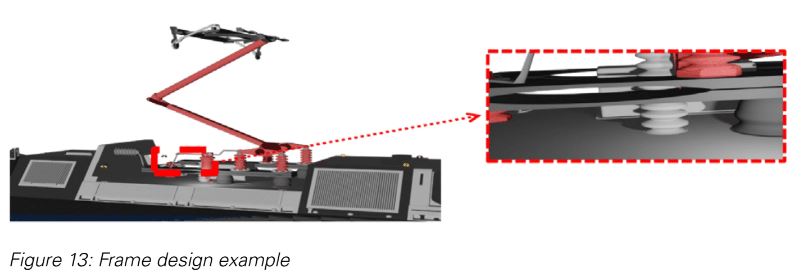
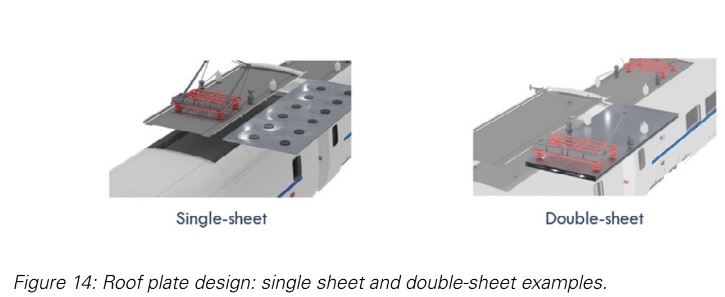
Horn directivity (Figure 15) – acoustic antennas are being analyzed with fundamental frequencies of about 370 Hz and 660 Hz. The horn directivity is modified by means of resonant antennas, directing the sound in a cone around the traveling direction, hence reducing the sound level in the driver’s cabin. Considering the space constraint and the relatively low frequencies involved, designs with sub-wavelength scale dimensions are a potentially promising alternative.
Horn cover (Figure 16) – locally resonant metamaterials attached or embedded in the panels and/or covers to increase the sound transmission loss from the horn to the driver’s cabin.

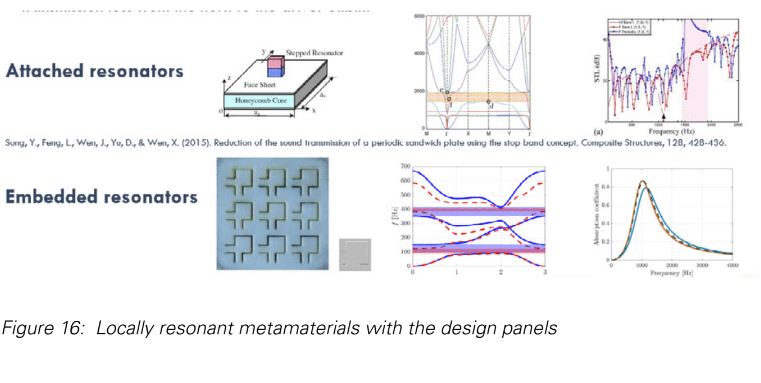
Advances and innovations in TRANSIT
With all these analyses and through the development of the above-mentioned methods, TRANSIT aims at enabling future low noise railway vehicles with a reduced environmental impact and an improved interior acoustic comfort. This is achieved by developing accurate and robust source characterization and separation methods and techniques, and exterior noise simulation tools that will make virtual testing and more cost-effective vehicle certification and homologation methods possible. For interior noise control, innovative material designs to increase sound transmission loss and absorption will be developed, leading to an improved interior sound quality within the weight constraints.
Installation effects and refraction in the transmission paths
The Boundary Element Energy Method (BEEM) successfully applied in the prediction of automotive exterior noise will be used to model the sound radiation of bogie-mounted sources and other sources under the vehicle, and combined with ray-tracing techniques to predict railway exterior noise. This combined methodology has recently been applied to estimate the contribution of engine noise to pass-by noise in cars and will be adapted to trains in TRANSIT. Furthermore, diffraction effects for a roof-mounted source, a source mounted on the underframe, and a source in the bogie will be studied using a 2.5D boundary element method, analytical diffraction models, and a ray-tracing approach. The results will be compared with experimental results and the energy BEEM method. The most promising approach(es) will be implemented in the global exterior noise modeling tool.
Estimation of uncertainty on predicted noise levels
The sensitivity of the global model predictions to uncertainties in the source strengths, directivities, and installation effects will be studied in a number of scenarios and the propagation of uncertainty will be quantified. The methodology will be further developed, paying special attention to the accurate definition of the uncertainties in the input source strengths. Additionally, the application of IBF, an inherently statistical method, will provide built-in tools to estimate the uncertainties of source strength measurement.
The validated exterior noise simulation tool
The global exterior noise simulation tool will be experimentally validated for a stand-still vehicle for at least two of the most relevant sources. This result will be a consequence of the advances in the modeling of installation effects and characterization of source sound power and directivity.
Definition of strength and directivity of sources
Advancements along two paths will be sought. The first is to take the next step along the line started in Acoutrain and characterize the source based on sound power measurements according to ISO3744 (instead of using a calibrated monopole source). The second path is to apply the IBF method, based on microphone array measurements, to the characterization of source strength and directivity of railway sources (e.g, a traction motor, an HVAC fan unit, and a transformer). The tests should be conducted at a supplier in the test rig or environment which normally is used. An advantage of IBF is that it can be used for in-situ source characterization, which could potentially allow for validation of installation effects on the source strength and directivity.
Equivalent source models to represent strength and directivity
Models based on equivalent elementary sources (e.g. monopole, dipole) will be developed. The effect of reducing the number of equivalent monopoles on source strength and directivity condition will be analyzed, by comparing sound radiation in free field with the full and reduced sets of equivalent sources. In particular, a correlation with the 5 equivalent monopoles derived from measurement according to the ISO3744 standard will be done (search of an optimized set of 5 equivalent monopoles that reconstruct as precisely as possible the source directivity and comparison with the 5 sources derived from ISO 3744 measurements).
Improved pass-by source separation including source strength and directivity
Methods based on microphone arrays successfully applied in other fields such as rotating machinery, aerospace, and automotive will be extended or adapted to the needs of railway pass-by source separation measurements. Separation of aerodynamic noise sources, traction, and equipment noise sources will be achieved, including estimation of sound power for the sources in third-octave bands and information on the directivity of sound radiation. Two promising methods are CMF and SODIX. The source models for the CMF method will be enhanced with information from the source models and transfer functions developed in source and transmission characterization for exterior noise field in the TRANSIT project. It is expected that this will improve the resolution and the accuracy of the source strength calculation. Regarding source directivity, the SODIX method will be explored. Regarding methods not involving the use of microphone arrays, the PBA-based approach described above will be improved and adapted using the total rolling noise transfer function and combined roughness to separate out the contribution of other sources.
Validation and uncertainty assessment
Uncertainty estimation methods based on error propagation and Monte-Carlo approaches will be developed and the source separation results will be validated by comparison to the exterior noise simulation tool developed and validated in source and transmission characterization for exterior noise.
Enhancement and simplification of separation methods
Three families of separation methods will be enhanced and simplified: PBA, ATPA, and TWINS-based. PBA methods provide the combined effective roughness and total transfer function from combined effective roughness to sound pressure. Source separation will be achieved by splitting the total transfer function into a track and vehicle part, based on stationary measurements. For the ATPA method simplifications of the method will be explored in terms of the number of measurement transducers and the number of static measurements required. Regarding TWINS-based separation methods, a set of ‘standard’ vibro-acoustic transfer functions for the track will be developed, so that track noise can be estimated simply from measured rail vibration. Recent improvements to acoustic radiation models for track components will be incorporated into these estimates.
Separation of wheel and rail roughness
A method will be developed for separation of combined roughness into a wheel and rail contributions starting from the combined roughness of the whole train or parts of the train, and applying either known rail roughness at the site with a contact filter or assessing multiple pass-bys from trains with different wheel roughness, or from individual wheels within the same train. This will result in an absolute level and a threshold level of wheel or rail roughness, depending on which is lowest.
Separation of vertical and lateral rail vibration contributions
The PBA, ATPA, and TWINS-based methods make use of vertical and lateral rail vibration measurements during pass-by to establish the track contribution. The developments to enhance these methods described earlier will lead to separating the contributions of vertical and lateral rail vibration (and sleeper vibration) to the total track noise.
Transposition methods
Transposition of pass-by rolling noise from one track to another will be investigated building on work done in Acoutrain, which illustrated some limitations when converting between widely different track types such as ballasted track and slab track. A better understanding of the physical factors involved will be sought, supported by TWINS simulations. The feasibility of developing a method for transposition using the ATPA method will be investigated as well.
Feasibility study of innovative solutions
A comprehensive feasibility study for design solutions concentrating on different parts of the interior noise generation chain will be produced. Solutions to increase sound absorption at the source, increase sound attenuation in ducts and through panels, reduce structure-borne transmission through the car body structure, and increase acoustic absorption in the car will be proposed and assessed against criteria established by the associated project FINE-2.
New designs for improved interior noise comfort
New designs based on (meta)-structures tailored to maximize attenuation at selected frequency regions will be proposed and optimized. Hybrid constructions potentially combining light metal alloys and composite materials that can be manufactured with 3D printing technique will be explored, in line with other expected developments within Shift2Rail (S2R-OC-IP1-01-2019). Inspiration will be sought in successful designs from other application areas, such as liners for aero-engines. The designs will be experimentally validated in laboratory tests.
Concluding remarks
The key to predicting overall noise levels accurately for stand-still or in the vicinity of the track during pass-by is an accurate separation and characterization of the main contributing sources and this is the core of the research work in TRANSIT: to identify the sound power and directivity of the main sources of railway noise and establish their contribution to the total measured levels. These results are the input to the exterior noise simulation tool that will be developed taking the Acoutrain-tool as the starting point. Furthermore, although not included directly in TRANSIT, the source models are a valuable input for the interior noise simulation models developed in previous S2R projects Fine1 and Destinate. In TRANSIT, new material designs and their corresponding absorption and transmission loss properties will be modeled, which can subsequently be introduced in the interior noise simulation models to assess their performance.
The main obstacle for current vehicle certification methods is the fact that the track is the main contributor to pass-by noise in combination with the inability to accurately separate vehicles and track contributions. TRANSIT will target this problem by developing methods to identify the contribution of vehicle sources and to separate the vehicle and track contributions to rolling noise, based on the most promising approaches from Roll2Rail. Furthermore, an operator experienced in EU research projects (Metro de Madrid) will provide practical guidance and availability of rolling stock to test and validate, if necessary, the methodologies developed within TRANSIT.
TRANSIT is firmly based on the results from past EU projects Acoutrain and Roll2Rail and relies on the inputs from S2R Member projects FINE1 and FINE2 to set the next steps towards virtual certification. Furthermore, a key aspect to maximize the visibility, impact, and acceptance of the TRANSIT results is the interaction with relevant stakeholders such as the steering committee of the Shift2Rail Cross-cutting Activity (CCA) Noise, the EU Agency for Railways (ERA), and TC256/WG3 of the European Committee for Standardization (CEN).
For further information about the project and partners, please, visit the project website.


